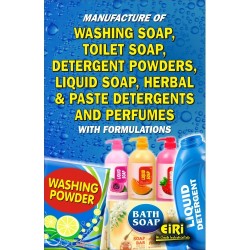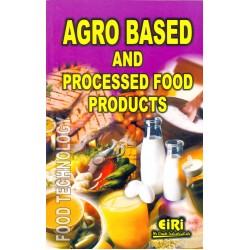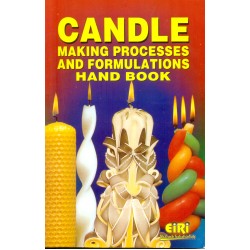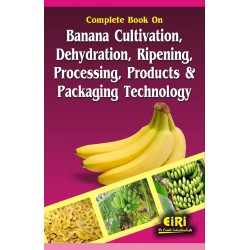Technology of Spices (Masala) And Condiments With Project Profiles (Cultivation, Uses, Extraction, Compositions And Processing)

- More than 40 years of experience
- Managed by expert industrial consultants
- ISO 9001-2015 Certified
- Registered under MSME, UAM No: DL01E0012000
- 24/5 Research Support
Get your quesries resolved from an industry expert. Ask your queries before report or book purchase. - Custom Research Service
Speak to the our consultant to design an exclusive study to serve your research needs. - Quality Assurance
All reports are prepared by highly qualified consultants & verified by a panel of experts. - Information Security
Your personal & confidential information is safe & secure.
The book Technology of Spices (Masala) and Condiments with Project Profiles (Cultivation, Uses, Extraction, Compositions and Processing) covers Amla, Black Pepper, Cardamom, Chilli, Clove, Curcumin, Garlic, Ginger, Mint, Tamarind, Turmeric, Plant Economics of Amla Plantation, Processing and Preservation, Plant Economics of Black Pepper, Plant Economics of Clove Oil , Plant Economics of Curcumin, Plant Economics of Dry Ginger Powder and Oleoresin, Plant Economics of Drying of Red Chillies, Haldi, Dhania, Peas and Green Peas, Plant Economics of Peppermint Cultivation and Processing, Plant Economics of Tamarind Kernel Powder, Plant Economics of Turmeric Oil Extraction from Dry Turmeric.
TECHNOLOGY OF SPICES (MASALA) AND CONDIMENTS WITH PROJECT PROFILES (CULTIVATION, USES, EXTRACTION, COMPOSITIONS AND PROCESSING)
AMLA
- Family Euphorbiaceae
- Description
- Habitat
- Ayurvedic medicine\
- The Ayurvedic description of Amla\
- Chemical constituents
- Preparations
- Description of the plant\Parts used
- Uses of Amla
- Boils and spots
- Skin sores and wounds
- Tonic
- Water purification
- Tibet
- Bioactive Components Retention in Processed Indian Gooseberry Products
- Material and Methods
- Raw material
- Pre preparation of the amla
- Flow diagram for the preparation of Amla Toffee
- Total soluble solids
- Moisture, crude, fat, protein and titrable acidity
- Flow diagram for the preparation of Amla Bar
- Ascorbic acid
- Flow diagram for the preparation of Amla candy
- Total phenolic content
- Determination of anti oxidant activity
- Storage studies
- Statistical analysis
- Result and Discussion
- Chemical Composition of Amla
- Effect of different processing treatment on the bioactive
- components of amla and its products
- Conclusion
BLACK PEPPER
- Climate and soil
- Varieties
- Propagation
- Important cultivars of black pepper and their characteristic features
- Improved varieties of black pepper and their characteristic features
- Production of rooted cuttings
- Nursery diseases
- Establishment of plantations
- Selection of site
- Preparation of land and planting standards
- Planting
- Cultural practices
- Manuring and fertilizer application
- Plant protection
- Diseases
- Management
- Stunt disease
- Use virus free healthy planting material
- Phyllody disease
- Slow decline (slow wilt)
- Insect pests
- Pollu beetle
- Top shoot borer
- Leaf gall thrips
- Scale insects
- Minor pests
- Organic Production
- Conversion plan
- Harvesting and processing
- Chemistry
- Volatiles
- Constituents of black pepper oil
- Monoterpene Hydrocarbons and Oxygenated Compounds
- Sesquiterpene hydrocarbons and Oxygenated Compounds
- Miscellaneous compounds
- Angular rotation of oil
- Variability in essential oil constituents
- Aromatic compounds of black pepper
- Aroma compounds in pepper oil
- Sensory evaluation of pepper essential oil
- Non volatiles
- Pungency of black pepper
- Properties, synthesis and estimation of piperine
- Pungent compounds of black pepper
- Medicinal and Pharmacological Properties
- Antioxidant acitivity
CARDAMOM
- Cultivation for cardamom
- Varieties
- Cultivar Malabar
- Cultivar Mysore
- Cultivar Vazhukka
- High yielding varieties and selections
- High yielding varieties and selections
- Climate and Soil
- Nursery Management
- Vegetative (sucker) propagation
- Seediling nursery
- Primary nursery
- Secondary Nursery
- Field Planting and Management
- Shade regulation
- Field preparation
- Planting
- Weed management
- Irrigation
- Soil and water conservation
- Forking and mulching
- Trashing and pruning
- Earthing up
- Lime application
- Manures and fertiliser application
- Application of Organic Manures
- Schedule for the use of NPK fertilizers
- Soil application
- Time and Method of application
- Soil application
- Foliar application
- Use of Micronutrients
- Harvesting and post harvesting
- Stage of Harvest
- Post harvest Operations
- Curing
- Cleaning, Grading, Packing and Storage
- Small Cardamom
- Chemistry
- Main components of volatile oil present in small cardamom
- Trace components in cardamom volatile oil
- Variability in oil composition
- Variety and location
- Major essential oil components in small cardamom
- Major essential oil components in small cardamom
- Fixed oils
- Medicinal and Pharmacological Properties
- Major compounds identified in Elettaria cardamomum
- Flavour characteristics of some important volatile components of cardamom
- GC MS based comparison of essential oil constituents of Indian, Guatemalan and Sri Lankan cardamom
- Pharmacological Properties
- Antimicrobial activity
- Antioxidant effect
- Anti inflammatory activity
- insecticidal activity
- Large Cardamom
- Chemistry
- Percentage composition of oils from the seeds of Amomum subulatum
- Medicinal and Pharmacological uses
- Anti inflammatory
- Antidote to snake venom
- Hepatoprotective
- Anti ulcerogenic
- Major essential oil components in large cardamom
CHILLI
- Origin
- Importance
- Nutritional value of chilli (Mirchi)
- Post Harvest Management
- Traditional Sun drying
- Post Harvest Losses
- Harvesting and Post harvest Care
- Scientific drying platform constructed by spices board
- Grading
- Adulerants and Toxins
- Toxins
- Grading at Producer's Level
- Packaging
- Packaging
- Packaging materials
- Method of Packing
- Cultivation practices
- Crop Management
- Extraction of Oleoresin from Pungent Red Paprika
- Materials and methods
- Plant material
- Extraction procedure
- Determination of pungent capsicum oleoresin yield
- Determination of capsaicin content in pungent capsicum oleoresin
- Determination of capsanthin content in pungent capsicum oleoresin
- Apparatus
- Optimization of extraction conditions
- Chemistry
- Colour and pigments
- Carotenoid compounds
- The optimum combined condition predicted values for dependent variables at optimal values of variables
- High capsaicin chilli
- Flavour and aroma
- Medicinal and Pharmacological Properties
- Antioxidant activity
- Anticancerous activity
- Affatoxigenic activity
- Non lethal use of capsaicin
CLOVE
- Climate and Soil
- Varieties and Planting Material
- Nursery Practices
- Site Selection and Planting
- Manuring
- Plant Protection
- Pests
- Diseases
- Harvesting and Curing
- Yield
- Method for processing dried whole cloves
- Volatiles of clove oils
- Essential oil composition of clove bud and leaf from India and Madagascar.
- Medicinal and Pharmacological Uses
- Antimicrobial activity
CURCUMIN
- Chemistry
- Biosynthesis
- Potential medical uses
- Anticarcinogenic effects
- Bioavailability
- Potential risks and side effects
- Curcumin, Disease and Ulcerative Colitis
- Curcumin and Cystic Fibrosis
- Curcumin and Cancer
- Curcumin and Prion Related (Mad Cow) Diseases
- Curcumin and Alzheimers
- Anti inflammatory Effects of Curcumin
- Curcumin as an Antioxidant
- Cardiovascular Effects of Curcumin
- Curcumin's Antimicrobial Effects
- Hepatoprotective Effects of Curcumin
- Curcumin Side Effects
- Curcumin Drug Interactions
- Curcumin Dosage Information
GARLIC
- Chemical constituents
- Chemical constitution of garlic
- Cultivation
- Climate and Soil
- Land Preparation
- Time of Planting
- Scacing
- Varieties
- Manures and fertilizers
- Interculture and weeding
- Irrigation
- Plant Protection
- Pest
- Diseases
- Physiological Disorders
- Synthesis of Allicin (Garlic)
- Synthesis of Allicin
- Methods
- Results
- Conclusion
- Antimicrobial properties of allicin from garlic
- Antibacterial activity of allicin
- Sensitivity of various bacterial species to allicin
- Effect of allicin on various fungal pathogens
- Antifungal activity of allicin
- Antiparasitic properties of allicin
- Antiviral activity of allicin
- Mechanism of action of allicin
- Anticancer properties
GINGER
- Etymology
- Horticulture
- Uses
- Ginger acts as a useful food preservative
- Use
- Medical use & research
- Chemistry
- medicine
- Nutritional information
- Ginger root (ground)
- Ginger root (raw)
- Safety
- Organic cultivation of Ginger (Adrak)
- sources of planting material
- Preparation of land and planting
- Cultural practices
- Manuring
- Plant protection
- Diseases
- Harvesting and post harvest operations
- Preservation of seed rhizomes
- Aeroponic Cultivation of Ginger (Z.officinale) Rhizomes
- Materials and Methods
- Results
- Growing Media Treatments
- Heated vs. Unheated Nutrient Solution Treatments
- Discussion
- Conclusion
- Extraction of ginger oil by hydro distillation
- Vapour Pressure Measurement
- Vapour pressure measurement set up
- Quality analysis
- Results and Discussions
- The improved steam distillation equipment set up
- Improve Design of the Steam Distillation Equipment
- Phytochemical composition of Zingiber officinale
- Chemicals
- Medicinal properties of Zingiber officinale
- Nutrient Composition
- Pharmacological studies
- Antimicrobial activity
- Anti diabetic activity
- Nephroprotective activity
- Hepatoprotective activity
- Larvicidal activity
- Anticancer activity
- Analgesic activity
- Anti inflammatory activity
- Immunomodulatory activity
- Anthelmintic property of ginger
- Antioxidant activity
- Toxicity
- Conclusion
- Therapeutic effects of ginger
- Ginger and oxidation
- Ginger and inflammation
- Ginger and cancer
- Ginger, hyperlipidema and hyperglycaemia
- Ginger, nausea and vomiting
- Ginger and blood circulation
- Other properties of ginger
- Extraction of Ginger Oleoresin from Ginger Root Using Supercritical CO2
- Environmental Significance
- Process Description
- Necessary Information and Simulation Hints
- Ginger Oleoresin Extraction Stream Table
- (6)- gingerol content and bioactive properties of ginger (Zingiber officinale Roscoe) extracts from supercritical CO2 Extraction
- Materials and Methods
- Chemical structure of (6) gingerol (5-hydroxy-1 (4) uhdroxy-3y methoxyphenyl)-3 decanone)
- Drying of fresh mature ginger
- SC-CO2 extraction of ginger
- Results and Discussion
- Chemical and bioactive properties of fresh and dried ginger
- Chemical and bioactive properties of ginger extracts from SC-CO2 extraction
- Changes in (6) gingerol content during drying process at 55+/ 2uC
- PFD Extraction of Ginger Oleoresin from Ginger root
- Ginger Clones Studied, Their Genotype, and Their Origin
- Conclusion
- Structures of the major pungent compounds in ginger, gingerols, and shogaols
- Gingerol Content of Diploid and Tetraploid Clones of Ginger (Z. officinate Roscoe).
- Materials and Methods
- Results
- Correlation between Gingerols
- Gingerol Ratios
- Results of Pairwise Analyses of 17 Ginger Clones in Terms of (6), (8) and (10) Gingerol Content
- Pearson Product Moment Correlations between the concentration of Gingerols in Fresh Rhizomes of 17 Ginger Clones Assayed by HPLC at Zero and Five Months
- Stability of Gingerols
- Gingerol Content of Tetraploid Clones
- Mean +/ SE (Range) Concentrations (ug/g) of Gingerols in Two Commercial Queens land Clones and 12 Tetraploid Clones
- Discussion
- Literature Data on Gingerol Content of Fresh Ginger Rhizomesa
- Ploidy
- Ginger oleoresin
- Solvent extracts
- Ginger Processing
- Formulation and baking process affect Maillard reaction development and antioxidant capacity of ginger cakes
- Materials and Methods
- The formulation of ginger cakes
- Measurement of MRP fluorescence and calclation of the FAST index
- Results and Discussion
- Contents of the total extractable phenolic compoundes (TPC) and antoxidant capacities of ginger doughs and cakes
MINT
- Species
- Taxonomy
- Selected hybrids
- Cultivation
- Uses
- Cultinary
- Medicinal and consmetic
- Insecticides
- Room scent and aromatherapy
- Diseases
- Botany
- Ecology
- Cultivation
- Uses
- Peppermint oil
- Toxicology
- Chemistry
- List of the cultivars
- Flow chart diagram showing an existing method for purifying 1-menthol from crude mentha oil
- Flow chart illustrating embodiments of methods for producing 1-menthol
- Methods and apparatus for production of natural 1-menthol
- Flow chart illustrating embodiments of methods for producing 1-menthol
- A cross sectional of an exemplary crystallizer in some embodiments of the system for purifying 1-menthol disclosed herein
- L-Menthol Production
- Eembodiments of a system for purifying 1-menthol
- Methods
TAMARIND
- Description
- Vegetative morphology
- Root
- Leaves
- Flowers
- Flowers are bisexual
- Fruits and seeds
- Properties of the Species
- Mean composition of tamarind fruit
- Pulp
- Proximate composition and food energy value of ripe tamarind pulp (%) from five different areas
- Some physico chemical properties of the lipid extracted from the pulp and seed of tamarind
- Proximate composition of dried pulp of tamarind fruit per 100 g dry weight
- Chemical compositionof sweet tamarind pulp
- Seeds
- Composition of tamarind seed, kernel and testa(%)
- Amino acid content of tamarind and some food legumes, mg/g N (Total N)
- Seed Kernel Oil
- Fatty acid composition of tamarind seed oil
- Leaves and Flowers
- Chemical composition of tender leaves and flowers of Tamarind
- Average chemical composition of tamarind leaves used for browse
- Wood and bark
- Uses and Products
- Introduction
- Agroforestry and land use
- Socio cultural aspects
- Fruit and Food Products
- Pulp
- Seed
- Leaves and Flowers
- Twigs and Bark
- Lac
- Wood
- Medicinal uses
- Pulp
- Seed
- Leaves
- Bark, flower and root
- Veterinary use
- Industrial uses
- Tamarind Kernel Powder
- Pectins
- Average chemical composition of tamarind pectin
- Tamarind juice concentrate
- Chemical composition of tamarind juice concentrate and tamarind pulp powder (%)
- Tamarind pulp powder
- Tamarind pickle
- Construction
- Paper making
- Examples of household recipes
- Other uses
- Design and Fabrication of Tamarind Cover and Seed Separation Machine
TURMERIC
- Nomenclatue and taxonomy
- Uses in medicine
- Medical research
- Cosmetics
- Dye
- Gardening
- Uses
- Composition
- Curcumin Enol form
- Curcumin Keto form
- Turmeric Cultivation and Processing in India
- Climate and soil
- Varieties
- Cultivation
- Fertilizer schedule for turmeric per ha)
- Manuring and fertilizer application
- Mulching
- Weeding and irrigation
- Mixed cropping
- Plant protection
- Diseases
- Insect pests
- Organic Production
- Management
- Harvesting
- Sweating
- Adulteration
- Varieties of turmeric
- Allepey
- Madras
- West Indian
- Standards
- processing of Turmeric (Haldi)
- Curing
- Large scale boiling unit for steam boiling of turmeric (Haldi)
- Drying
- Polishing
- Colouring
- Preservation of seed rhizomes
PLANT ECONOMICS OF AMLA PLANTATION, PROCESSING AND PRESERVATION
- Plant and Machinery
- Fixed Capital
- Raw Materials
- Total Working capital/Annum
- Total Capital Investment
- Turn Over/Annum
PLANT ECONOMICS OF BLACK PEPPER
- Plant and Machinery
- Fixed Capital
- Raw Materials
- Total Working capital/Annum
- Total Capital Investment
- Turn Over/Annum
PLANT ECONOMICS OF CLOVE OIL
- Plant and Machinery
- Fixed Capital
- Raw Materials
- Total Working capital/Annum
- Total Capital Investment
- Turn Over/Annum
PLANT ECONOMICS OF CURCUMIN
- Plant and Machinery
- Fixed Capital
- Raw Materials
- Total Working capital/Annum
- Total Capital Investment
- Turn Over/Annum
PLANT ECONOMICS OF DRY GINGER POWDER AND OLEORESIN
- Plant and Machinery
- Fixed Capital
- Raw Materials
- Total Working capital/Annum
- Total Capital Investment
- Turn Over/Annum
PLANT ECONOMICS OF DRYING OF RED CHILLIES, HALDI, DHANIA, PEAS AND GREEN PEAS
- Plant and Machinery
- Fixed Capital
- Raw Materials
- Total Working capital/Annum
- Total Capital Investment
- Turn Over/Annum
PLANT ECONOMICS OF PEPPERMINT CULTIVATION AND PROCESSING
- Plant and Machinery
- Fixed Capital
- Raw Materials
- Total Working capital/Annum
- Total Capital Investment
- Turn Over/Annum
PLANT ECONOMICS OF TAMARIND KERNEL POWDER
- Plant and Machinery
- Fixed Capital
- Raw Materials
- Total Working capital/Annum
- Total Capital Investment
- Turn Over/Annum
PLANT ECONOMICS OF TURMERIC OIL EXTRACTION FROM DRY TURMERIC
- Plant and Machinery
- Fixed Capital
- Raw Materials
- Total Working capital/Annum
- Total Capital Investment
- Turn Over/Annum
How to Make Project Report?
Detailed Project Report (DPR) includes Present Market Position and Expected Future Demand, Technology, Manufacturing Process, Investment Opportunity, Plant Economics and Project Financials. comprehensive analysis from industry covering detailed reporting and evaluates the position of the industry by providing insights to the SWOT analysis of the industry.
Each report include Plant Capacity, requirement of Land & Building, Plant & Machinery, Flow Sheet Diagram, Raw Materials detail with suppliers list, Total Capital Investment along with detailed calculation on Rate of Return, Break-Even Analysis and Profitability Analysis. The report also provides a birds eye view of the global industry with details on projected market size and then progresses to evaluate the industry in detail.
We can prepare detailed project report on any industry as per your requirement.
We can also modify the project capacity and project cost as per your requirement. If you are planning to start a business, contact us today.
Detailed Project Report (DPR) gives you access to decisive data such as:
- Market growth drivers
- Factors limiting market growth
- Current market trends
- Market structure
- Key highlights
Overview of key market forces propelling and restraining market growth:
- Up-to-date analyses of market trends and technological improvements
- Pin-point analyses of market competition dynamics to offer you a competitive edge major competitors
- An array of graphics, BEP analysis of major industry segments
- Detailed analyses of industry trends
- A well-defined technological growth with an impact-analysis
- A clear understanding of the competitive landscape and key product segments
Need Customized Project Report?
- Ask for FREE project related details with our consultant/industry expert.
- Share your specific research requirements for customized project report.
- Request for due diligence and consumer centric studies.
- Still haven't found what you're looking for? Speak to our Custom Research Team
About Engineers India Research Institute:
Note: We can also prepare project report on any subject based on your requirement and country. If you need, we can modify the project capacity and project cost based on your requirement.
Our Clients

Our Approach
- Our research reports comprehensively cover Indian markets (can be modified as per your country), present investigation, standpoint and gauge for a time of five years*.
- The market conjectures are produced on the premise of optional research and are cross-accepted through associations with the business players
- We use dependable wellsprings of data and databases. What's more, data from such sources is handled by us and incorporated into the report
Why buy EIRI reports?
- Our project reports include detailed analysis that help to get industry Present Market Position and Expected Future Demand.
- Offer real analysis driving variables for the business and most recent business sector patterns in the business
- This report comprehends the present status of the business by clarifying a complete SWOT examination and investigation of the interest supply circumstance
- Report gives investigation and top to bottom money related correlation of real players/competitors
- The report gives gauges of key parameters which foresees the business execution






















-250x250.jpg)


-250x250h.jpg)









